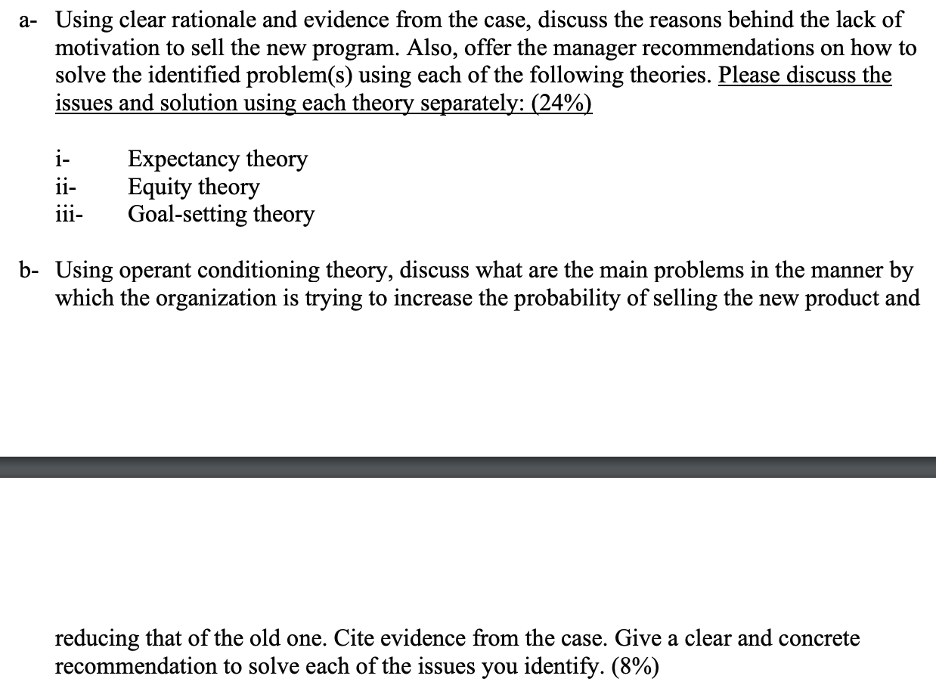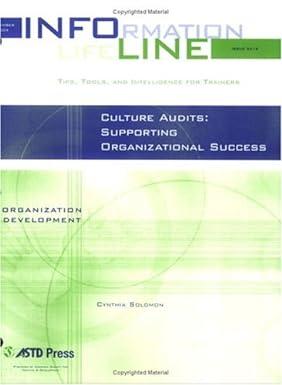

Safi manages a team of elite sales representatives at a mid-sized software company. Due to technological changes, their main document-management product has become redundant. The old product helped companies manage complex libraries of data such as their patents, the technical specifications of their products, and policy and procedure manuals. The new content management product handles similar tasks, but with an important innovation: it also helps companies manage the largest and most complex websites that have many authors contributing simultaneously. Since these software systems are complex and customized to each organization, it usually takes 7 to 9 months to close a dealthat is, from the first contact with the customer to when the system is installed and the client receives training. Safi has noticed that the sales reps aren't really pushing the new product and sales are sluggish. The sales reps get a small salary (about $22,000), but on average 65 to 85% of their total income comes from commission. Both products have commission rates of 6% for new sales and 15% for annual maintenance contract renewals. Renewals for both products are required for ongoing access to technical support services and are therefore considered mandatory by the overwhelming majority of their customer base. The existing customer base is quite large; it is possible to achieve the minimum acceptable sales quota by selling only renewals in some territories. Employees believe that achieving quota is the single most important thing, as it is what sales representatives receive public recognition during their annual sales meetings. New deals are considered more prestigious than contract renewals, but they are also riskier. The average new deal is worth anywhere from $100,000 to $450,000, but such deals can take months to close and some fall through at the last minute. Renewal prices are based on the value of the original contract and range from 5% of the original purchase price to 12% depending on the level of service desired. At the end of the year, salespeople receive a reward of 5% of the overall company's net profit. Safi attempts to motivate the sales reps to push the new product. She repeatedly discusses the product with them. Also, since the product is so new and customer feedback is still lacking, she was hesitant to come up with a fixed number representing good performance. Instead, she simply told them that she needs them to work hard at it, and in doing so good things will come. Finally, to incentivize them more, she also told them that she might be able to get the company to push the yearly reward up to 7.5%. Three months later, Safi was still seeing sluggish sales, and began to wonder whether there was something wrong with her approach. (32%) a- Using clear rationale and evidence from the case, discuss the reasons behind the lack of motivation to sell the new program. Also, offer the manager recommendations on how to solve the identified problem(s) using each of the following theories. Please discuss the issues and solution using each theory separately: (24%) i- ii- iii- Expectancy theory Equity theory Goal-setting theory b- Using operant conditioning theory, discuss what are the main problems in the manner by which the organization is trying to increase the probability of selling the new product and reducing that of the old one. Cite evidence from the case. Give a clear and concrete recommendation to solve each of the issues you identify. (8%) Safi manages a team of elite sales representatives at a mid-sized software company. Due to technological changes, their main document-management product has become redundant. The old product helped companies manage complex libraries of data such as their patents, the technical specifications of their products, and policy and procedure manuals. The new content management product handles similar tasks, but with an important innovation: it also helps companies manage the largest and most complex websites that have many authors contributing simultaneously. Since these software systems are complex and customized to each organization, it usually takes 7 to 9 months to close a dealthat is, from the first contact with the customer to when the system is installed and the client receives training. Safi has noticed that the sales reps aren't really pushing the new product and sales are sluggish. The sales reps get a small salary (about $22,000), but on average 65 to 85% of their total income comes from commission. Both products have commission rates of 6% for new sales and 15% for annual maintenance contract renewals. Renewals for both products are required for ongoing access to technical support services and are therefore considered mandatory by the overwhelming majority of their customer base. The existing customer base is quite large; it is possible to achieve the minimum acceptable sales quota by selling only renewals in some territories. Employees believe that achieving quota is the single most important thing, as it is what sales representatives receive public recognition during their annual sales meetings. New deals are considered more prestigious than contract renewals, but they are also riskier. The average new deal is worth anywhere from $100,000 to $450,000, but such deals can take months to close and some fall through at the last minute. Renewal prices are based on the value of the original contract and range from 5% of the original purchase price to 12% depending on the level of service desired. At the end of the year, salespeople receive a reward of 5% of the overall company's net profit. Safi attempts to motivate the sales reps to push the new product. She repeatedly discusses the product with them. Also, since the product is so new and customer feedback is still lacking, she was hesitant to come up with a fixed number representing good performance. Instead, she simply told them that she needs them to work hard at it, and in doing so good things will come. Finally, to incentivize them more, she also told them that she might be able to get the company to push the yearly reward up to 7.5%. Three months later, Safi was still seeing sluggish sales, and began to wonder whether there was something wrong with her approach. (32%) a- Using clear rationale and evidence from the case, discuss the reasons behind the lack of motivation to sell the new program. Also, offer the manager recommendations on how to solve the identified problem(s) using each of the following theories. Please discuss the issues and solution using each theory separately: (24%) i- ii- iii- Expectancy theory Equity theory Goal-setting theory b- Using operant conditioning theory, discuss what are the main problems in the manner by which the organization is trying to increase the probability of selling the new product and reducing that of the old one. Cite evidence from the case. Give a clear and concrete recommendation to solve each of the issues you identify. (8%)








